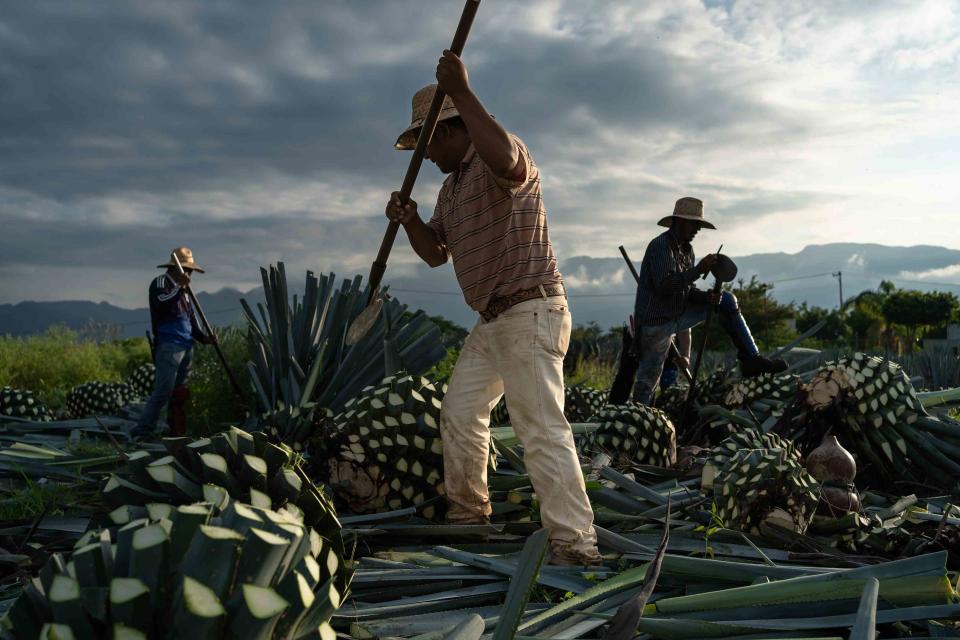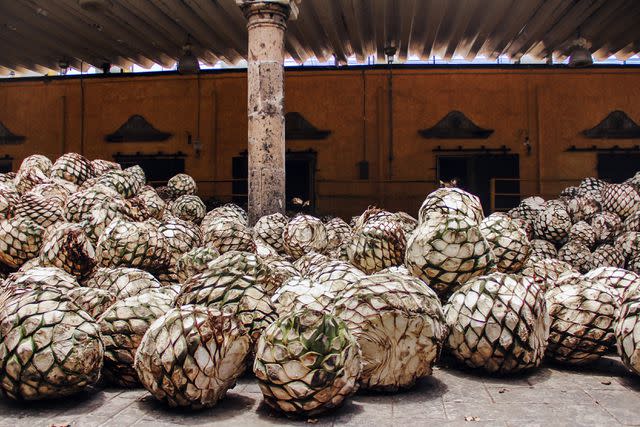Not All Mezcal Is the Same — Here's What to Know About All 3 Types
The agave-based Mexican spirit is much more diverse than many drinkers realize.

Jose de Jesus Churion / Getty Images
Mezcal is a beloved spirit around the world, distinct in style and flavor, and often completely misunderstood. No, there’s not just one type of mezcal, and no, it’s not smoky tequila. In fact, tequila is technically a type of mezcal — both spirits are made from agave plants, but tequila can only be made with Blue Weber agave, while mezcal can come from around 30 to 40 different varieties of agave.
Choosing which type of agave to use is just one of the many decisions a mezcalero (mezcal maker) has to make during mezcal production. To be considered true mezcal, it must be produced in Mexico in one of the certified states, which include Oaxaca, San Luis Potosí, Durango, Zacatecas, and Guerrero, with the vast majority produced in Oaxaca.
Emma Janzen, award-winning spirits writer and author of Mezcal: The History, Craft & Cocktails of the World’s Ultimate Artisanal Spirit, says that every tiny decision a mezcalero makes during the process is what makes mezcal so varied.
“The nitty-gritty details of how mezcal is made really differ by state, by region, and even by town,” says Janzen. “What tools and materials are being used by the mezcalero, and then also the way that they use them. All those tiny decisions — hundreds of tiny decisions that are made along the way — are going to change the flavor of the mezcal.”
There are three categories of mezcal: mezcal, mezcal artesanal, and mezcal ancestral, each defined by the way the spirit is produced.

Marcos Elihu Castillo Ramirez / Getty Images
“Ancestral mezcal is the most ancient — you have to cook [the agave] in earthen pits. You have to ferment in wood or clay, or tree trunks, and you have to distill in clay,” says Janzen. Producers also must mill by hand or using a tahona: a large, heavy stone wheel that crushes the roasted agave, separating the pulp from the juice.
Comparatively, mezcal artesanal is more of a modern process. “But not by a ton,” Janzen adds. Producers can use earthen pits or ovens made from brick, clay, or stone, and can use a tahona, hand mallet, or mechanical mill. Mezcal artesanal must also ferment in wood, animal skins, earthen pits, tree trunks, or tanks made of stone or concrete.
Industrial mezcal, which is just labeled as mezcal, is the most quick, efficient, and commercially produced at large volumes. “The mezcal that comes out of that process is probably going to have a lot more consistency,” explains Janzen. “They've streamlined everything to the point where the goal is to make this spirit with this kind of recognizable flavor profile. Now, if you get out of the industrial realm and back into artesanal and ancestral, that’s where consistency is less important.”
Regardless of category, the first choice a mezcalero must make is what agave to use. Different varieties of agave grow in different regions of Mexico, and depending on the area’s soil composition, annual rainfall, and other agricultural factors, all affect the raw material. Janzen says to think of it like wine grapes grown in different regions.
“It's a very terroir-driven spirit,” Janzen says. “An espadín that’s made in Oaxaca is going to taste way different than one made in Durango.” (Espadín is the most common type of agave used in mezcal production.) Based on the vessel the mezcalero uses during the fermentation process — leather, wood, clay, and so on — [this] will also impart specific characteristics into the final product: minerality, smokiness, spiciness, smoothness, florals, and more.
Related: 13 Mezcal Cocktails Our Editors Love
Of course, there’s one more crucial aspect that mezcaleros can play with. “One of the biggest factors in the development of flavor of the spirit is time,” says Janzen, adding that some (but not all) producers let the distillate rest in glass before bottling. “The more time that the spirit has to rest, the more the flavors kind of mellow and coalesce a little bit better. It's just one more step that producers can customize to have the final result that they're looking for.”
Fermenting mezcal takes anywhere from one to four weeks, but some mezcaleros choose to let the final products age in barrels to develop even more complexity. Joven, meaning “young” in Spanish, is unaged mezcal. Reposado mezcal is aged between two months and up to one year, and añejo mezcal is aged between one and three years. Extra añejo mezcal is anything aged longer than three years.
All of these factors contribute to the spectrum of mezcals produced today, from the type of agave harvested to how it’s cooked, milled, fermented, distilled, and aged. Janzen believes the misunderstood spirit is well worth the time it takes to experience the breadth of flavors it can provide.
For those who don’t know where to start, Janzen suggests going to a bar with a good collection of mezcals and asking the bartender questions or ordering a flight to try several next to one another. Because single bottles of mezcal can retail upwards of $100, if you aren’t sure what you like quite yet, that sort of investment can lead to discouragement quickly.
Related: Diving Deep into Mezcal, Sip by Sip
“Mezcal can have a super bright jalapeño, waxy, lemon kind of flavor, and if that's not your bag, if you really want something that's got more of the roasted notes like chocolate, ash, and sweet potato, that's going to be a totally different bottle,” says Janzen. “There aren't really good, quick shortcuts in this category, so I would definitely recommend going to talk to a bartender.”
The more you explore, the more you’ll discover, and there’s almost certainly a mezcal for every type of palate out there. “Mezcal is just so much more complicated than whiskey or vodka,” Janzen says. “I've been drinking mezcal for 15 years at least, and I still occasionally pick up bottles that are totally surprising, or maybe not what I thought they would be.” It’s precisely that unpredictability that keeps her coming back.
For more Food & Wine news, make sure to sign up for our newsletter!
Read the original article on Food & Wine.

